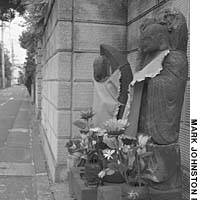Dear Alice,
Being an academic, I get to meet people researching all sorts of interesting topics, often completely unrelated to my own field. For example, I recently met a fellow Swede who is studying the practice of creating temporary memorials at the site of fatal traffic accidents. I was able to inform her that one sees this in Japan, too, with the site typically marked by bouquets of flowers and perhaps offerings of the unfortunate victim's favorite drink or snack. But now I'm wondering about the small stone statues one sees at roadsides all around Japan, one of which I've photographed for you. Are they, too, memorials at the site of a tragedy, albeit older and more permanent? If not, what the heck are they?
Jan. M., Osaka
Dear Jan,
Your inquiry struck a poignant note here at the Japan Times because a couple of weeks before it arrived a pedestrian was struck and killed by a cement truck just a few yards from our building. For about a week, a police officer directed traffic at the site and mourners left flowers and other small tributes.
So I was feeling somber as I read through your question. But I perked up a little when I looked at the accompanying photo and realized I had a partial answer for you, right off the bat, thanks to a paper I wrote in college. That was so long ago that I actually typed it on a typewriter.
The statue in your photo was wearing a cloth bib and beanie, an immediate tip off that it represents a deity called Jizo, although most Japanese use full honorifics and say either O-Jizo-san or O-Jizo-sama.Jizo originated in India as the bodhissatva Kshitigarbha and spread with Buddhism first to China and Korea and then to Japan.
The earliest record of this deity in Japan is from the eighth century, according to Kunihiko Shimizu, a Jizo scholar and assistant professor at Kanazawa University. Later, Jizo became an object of worship and gradually one of the Japan's most beloved and popular divinities. His main gig is to watch over children and babies (thus the sissy outfit) but he is also the guardian of expectant mothers, fireman, pilgrims and travelers. Basically, we've all got a friend in Jizo. Most of the Jizo statues you see along roads in Japan date back to the Edo period (1603-1867), Prof. Shimizu told me. They were erected along travel routes for the convenience of travelers and pilgrims, who would stop at such dosojin (roadside gods) and pray for a safe onward journey.
Despite the fact that Japanese traffic fatalities have decreased steadily since the 1970s, it has become more and more common to see temporary memorials along Japanese roads, according to Nobuho Tomita, professor of victimology at Tokiwa University and vice chairman of the National Network for Victim Support. This, he said, reflects growing comfort in Japan with public displays of grief. "Survivors used to be expected to keep a stiff upper lip," Prof. Tomita explained. "But now people will say things like 'uchi ni himenaide soto ni dashitemo ii' (don't keep [your grief] bottled up, it's ok to let it out)."
Both professors were interested to hear that people in countries other than Japan create temporary memorials at fatal traffic accident sites, and I promised to let them know how widespread the practice is. You kindly put me in touch with the researcher you mentioned, Anna Peterssen, a PhD student at Lund University, who reported that such tributes are most prevalent in Catholic countries but are seen throughout Europe, North America, South America and Australia.
Wherever you may be reading this, folks, please drive carefully. Anzen daiichi (safety first).



















With your current subscription plan you can comment on stories. However, before writing your first comment, please create a display name in the Profile section of your subscriber account page.